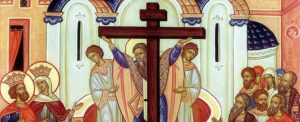
Each day of Holy Week has its own particular theme. The theme of Monday is that of the sterile fig tree which yields no fruit and is condemned. Tuesday the accent is on the vigilance of the wise virgins who, unlike their foolish sisters, were ready when the Lord came to them. Wednesday the focus is on the fallen woman who repents. Great emphasis is made in the liturgical services to compare the woman, a sinful harlot who is saved, to Judas, a chosen apostle who is lost. The one gives her wealth to Christ and kisses his feet; the other betrays Christ for money with a kiss.
On each of these three days the Gospel is read at the Hours, as well as at the Vespers when the Liturgy of the Presanctified Gifts is served. The Old Testament readings are from Exodus, Job, and the Prophets. The Gospel is also read at the Matins services which are traditionally called the “Bridegroom” services because the general theme of each of these days is the end of the world and the judgment of Christ. It is the common practice to serve the Bridegroom services at night.
Behold, the bridegroom comes in the middle of the night and blessed is the servant whom he shall find watching, and unworthy the servant whom he shall find heedless. Take care then, O my soul, and be not weighed down by sleep that you will not be given over unto death and be excluded from the Kingdom. But rise up and call out: Holy, Holy, Holy art Thou O God, by the Theotokos have mercy on us
The vigil on the eve of Holy Thursday is dedicated exclusively to the Passover Supper which Christ celebrated with his twelve apostles. The main theme of the day is the meal itself at which Christ commanded that the Passover of the New Covenant be eaten in remembrance of Himself, of His body broken and His blood shed for the remission of sins. In addition, Judas’ betrayal and Christ’s washing of His disciples feet is also central to the liturgical commemoration of the day.
Matins of Holy Friday are generally celebrated on Thursday night. The main feature of this service is the reading of twelve selections from the Gospels, all of which are accounts of the passion of Christ. The first of these twelve readings is Jn 13.31–18.1. It is Christ’s long discourse with his apostles that ends with the so-called high priestly prayer. The final gospel tells of the sealing of the tomb and the setting of the watch (Mt 27.62–66).
The twelve Gospel readings of Christ’s passion are placed between the various parts of the service. The hymnology is all related to the sufferings of the Savior and borrows heavily from the Gospels and the prophetic scriptures and psalms. The Lord’s beatitudes are added to the service after the sixth gospel reading, and there is special emphasis given to the salvation of the thief who acknowledged Christ’s Kingdom.
The first service belonging to Holy Saturday—called in the Church the Blessed Sabbath—is the Vespers of Holy Friday. It is usually celebrated in the mid-afternoon to commemorate the burial of Jesus.

Before the service begins, a “tomb” is erected in the middle of the church building and is decorated with flowers. Also a special icon which is painted on cloth (in Greek, epitaphios; in Slavonic, plaschanitsa) depicting the dead Savior is placed on the altar table. In English this icon is often called the winding-sheet.
Christ lies dead, yet he is alive. He is in the tomb, but already he is “trampling down death by death, and upon those in the tombs bestowing life.” There is nothing more to do now but to live through the evening of the Blessed Sabbath on which Christ sleeps, awaiting the midnight hour when the Day of our Lord will begin to dawn upon us, and the night full of light will come when we will proclaim with the angel: “He is risen, he is not here; see the tomb where they laid him” (Mk 16.6).
Adapted from The Church Year by the Orthodox Church of America.





